Are you looking to embed your Instagram feed seamlessly into your website? Or maybe you want to showcase user-generated content (UGC) and create a more interactive experience for your site visitors. Whatever your goal, Instagram widgets are the perfect way to make your website more dynamic and visually engaging. In this blog, we’re diving into some of the best free and affordable Instagram widget tools, with examples to inspire you and step-by-step instructions to get started. Whether you’re a small business, an ecommerce store, or a nonprofit, an Instagram widget can help you highlight your social presence, connect with your audience, and drive traffic to your website.
In this article, we cover free and affordable widgets, examples of Instagram content being displayed on websites, and an easy step-by-step tutorial on how to use a social media widget.
What is an Instagram widget?
An Instagram widget is a social media aggregator that you install in your website to show off your most recent Instagram posts. Most often, businesses are looking to showcase their own Instagram content, but brands might also choose to show off user generated content (UGC), meaning photos and videos that are posted by customers. In this case, the widget acts as a hashtag aggregator and collects content using your branded hashtag. For example, a hashtag for a company called Plum might be #plumlove or #plumcommunity.
Of course, when aggregating UGC, make sure that you set your Instagram widget to manual moderation so that you can approve posts that are relevant and appropriate.
Instagram widgets are incredibly versatile and can be embedded anywhere on your website, from homepages and product pages to blog posts and footers. Some widgets also offer advanced features, such as customizable layouts, analytics, and call-to-action buttons, making it easier to drive engagement and conversions. Whether you’re running a personal blog or managing a large-scale brand, Instagram widgets can help you build trust, boost brand visibility, and create a visually appealing online presence.
Benefits of Using an Instagram Widget
When you embed Instagram content on your website, you can make your site more visually appealing, engage visitors, and leverage social proof to build trust with your audience. Here are some key benefits of using an Instagram widget:
- Boosts engagement: Displaying fresh Instagram content directly on your website encourages visitors to interact with your posts, driving more likes, comments, and followers to your profile.
- Enhances visual appeal: Instagram feeds are designed to be eye-catching, making your website more attractive and dynamic with minimal effort.
- Showcases user-generated content (UGC): Displaying UGC helps build trust and credibility by featuring real customers using or enjoying your products or services.
- Drives conversions: By integrating calls-to-action (e.g., “Shop Now” or “Follow Us”) into your Instagram widget, you can guide visitors to take specific actions that benefit your business.
- Keeps your website fresh: Instagram widgets automatically update with your latest posts, ensuring your website always feels current and relevant.
Using an Instagram widget is an easy way to add value to your website while creating a stronger connection with your audience.
And the good news is that it’s very easy to set up. It only takes about 5 minutes to install. Then, you can login in weekly or monthly to curate new content as needed.
How to use an Instagram widget
Using an Instagram widget is super easy, and you don’t need any coding experience. Here’s a step-by-step breakdown to guide you:
1. Choose the type of Instagram content to aggregate
With Curator, you can aggregate content from 5 different types of Instagram content: Instagram Business Account, Instagram Business Hashtag, Instagram Business Mention, Instagram Stories, and Tagged or Collab Posts.

2. Decide on moderation settings
You can choose whether posts should be automatically approved and displayed on your website or manually reviewed before publishing.
- Automatic Moderation: Ideal for saving time if you trust all aggregated content to be appropriate.
- Manual Moderation: Gives you control to approve or delete posts, ensuring only relevant and on-brand content is displayed.
3. Connect your Instagram account and moderate the content
Log in to your Instagram Business Account and connect it to the widget tool. Once connected, you’ll have access to your aggregated content for moderation. Approve, delete, or rearrange posts to ensure they meet your desired standards and brand guidelines.
4. Select and customize a widget template
Choose a template that best suits the design of your website. Options may include grid layouts, carousels, or column-based displays. Most Instagram widgets, like Curator, allow for easy customization so you can:
- Match colors, fonts, and spacing to your website’s theme.
- Add branding elements like logos or call-to-action buttons (e.g., “Follow Us” or “Shop This Look”).

5. Embed and customize your widget
Once your widget is ready, you’ll receive an embed code to place it on your website. You can embed the widget on any webpage, such as the homepage, product pages, or blog posts. After embedding, refine the display settings further to ensure the widget seamlessly integrates with your website’s overall look and feel.

6. Keep your content fresh and updated
Instagram widgets automatically update with your latest posts, but it’s always a good idea to periodically review the widget to ensure it remains aligned with your brand’s evolving goals.
For more details, you can refer to our comprehensive guide on embedding your Instagram feed or try Curator’s free trial to explore the tool yourself—it’s incredibly intuitive and user-friendly!
For more details on these steps, you can check out our article on embedding your Instagram feed in your website, or just sign up for a free trial of Curator and give it a go! It’s super easy to use.
8 Instagram widget tools and website plugins
Here are the best free and affordable tools for adding an Instagram widget to your website:
1. Curator
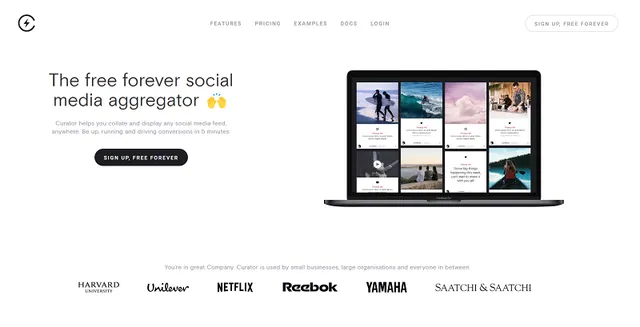
Curator is a social media aggregator that allows its users to pull content from accounts, hashtags, mentions and geolocations based on the specific social media platform. Curator is super easy-to-use for individuals and brands because it doesn’t have visible branding on the free plan without in-app purchases. Top features include hashtag aggregation, support for all major social media platforms, embeddable feeds, layouts and design options and moderation rules (so you can set posts to be automatically approved or you can login to approve them). Curator also has the best free plan available, and doesn’t put noticeable branding on your website. On all of the paid plans, you can completely remove the “Powered by Curator” link. Paid plans range from $20 to $200 per month.
What’s more Curator has a WordPress plugin, so you’ll have a no-code way to install your widget.
Sign up for Curator and add Instagram posts to your website in minutes.
2. Spotlyte

Spotlyte puts your customer’s content front and center via content aggregation. It pulls in your audience’s posts from across the web as well so you can see how they’re interacting with you and what kind of impressions they’re giving off to their own followers. Some features that make Spotlyte stand out include the ability to filter content by location to find UGC from customers in your target markets. You can also create loop schedules to show the same content again and again. However, Spotlyte is very expensive and the plans range from $95 to $495 per month.
3. Tint
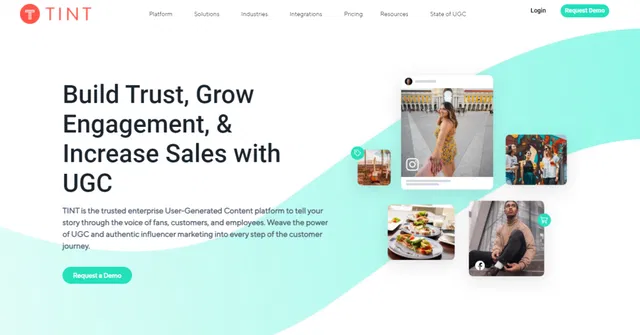
Tint helps you to aggregate content about your company or organization and let people submit their own content for display on your social media profiles and website. Tint lets you create social media contests and display the aggregated content from influencers on your website. Tint is designed for enterprise use and is very costly. You’ll need to contact their sales team for a custom quote.
4. Taggbox

Taggbox is a social media aggregator, which functions similarly to Curator. Taggbox allows you to create social calendars. With Taggbox, you can also create digital signs and displays that show the feeds of any one of your social accounts. The website helps users with branding and look-and-feel customization so their social aggregation feeds reflect the nature of their business. The plugin is easily added using its simple set of coding instructions, followed by pages targeting different platforms. Their free plan only offers 2 feeds and does inject noticeable branding on your website.
5. Juicer
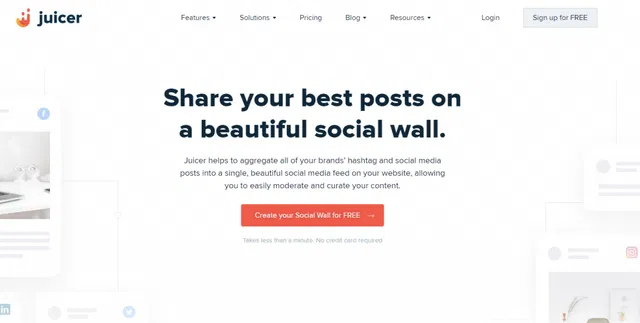
Juicer is an aggregator tool that you can use to moderate and display content from social media. Unfortunately, we can’t recommend it because of the prominently added branding that turns your website into a Juicer ad. On the free plan, you can only have one feed and Juicer branding appears on your website. On the large plan, you’ll pay $99 per month and receive three feeds without having to worry about any extra Juicer branding being placed on your website.
6. StoryStream
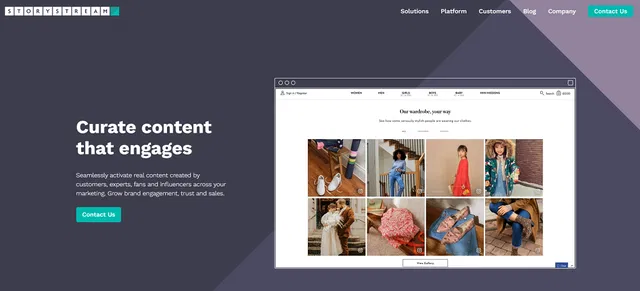
StoryStream is a hashtag aggregator for UGC, a digital asset management tool, and social commerce (link-in-bio and visual shopping solutions for brands, retailers, and marketplaces). It’s a fit for big brands looking to manage multiple types of social-media-related projects in one place. For this reason, it’s too costly for most companies simply looking for an Instagram widget software. However, if you own an ecommerce company, you might be able to benefit from its more advanced features.
7. Pixlee
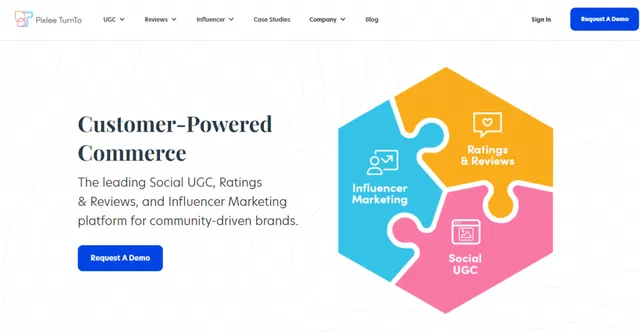
Pixlee lets you create, collect and manage user-generated content through their platform in order to display it across a variety of social channels including Instagram, Facebook and Twitter. The top features include UGC collection, curation, permissions; ratings and reviews management and displays; influencer campaign management. However, it is an enterprise platform and does cost several thousand dollars per year. You’ll need to contact their sales team for a custom quote that fits your needs.
8. Flockler

Flockler helps marketers display social feeds on your websites. Display your branded social feeds, hashtag campaigns, and user-generated content. With Flockler, you curate and show some of the most relevant social media content on your digital platforms.
7 Instagram widget examples
Want to see what Instagram widgets actually look like on real websites? We’ve chosen 7 very different examples to inspire your content curation.
1. Fashion Nova

This example from fast fashion brand Fashion Nova features styled looks with their signature sex appeal. “Shop Looks From The ‘Gram” is a simple and straightforward line of copy with plenty of personality.
2. Jungmaven

Hemp clothing brand Jungmaven keeps things even simpler by preceding their Instagram widget with nothing but their Instagram handle name. They use their Instagram content to bring forth their beachy, carefree, and youthful brand style.
3. City of Fresno

The City of Fresno in California has embedded their most recent Instagram content alongside their most recent Facebook posts, so that people can stay up to date with various events, initiatives, and other news.
4. The Comforted Kitty

This cat sitting service, which serves various towns in the Bay Area and Northern California as well as Las Vegas and Reno in Nevada, has used the footer of their website to embed an Instagram Widget. Nex to their contact information, the widget shows their four most recent Instagram posts and encourages website visitors to follow them.
5. Dover Saddlery
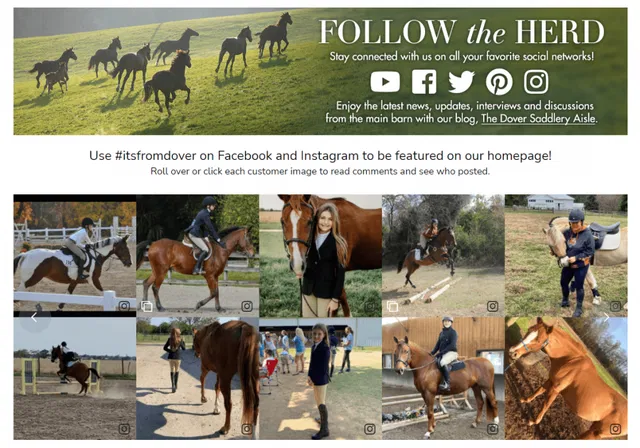
Dovler Saddlery is one of the best examples we’ve ever seen. Built with Curator, this Instagram widget example is so successful because it not only shows off their user generated content, but it also encourages customers to submit more great pictures.